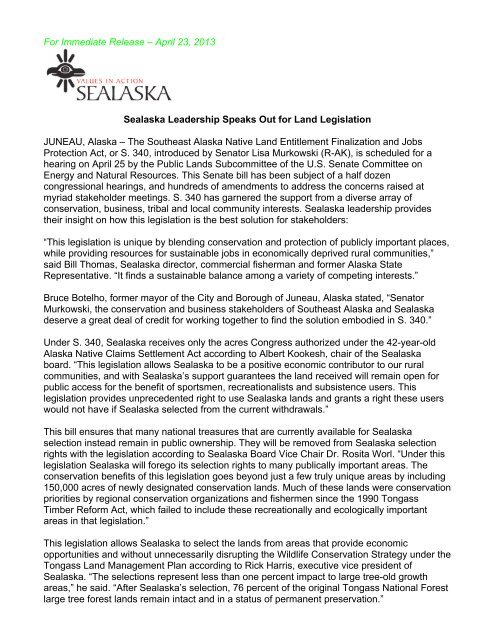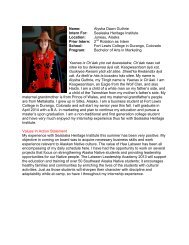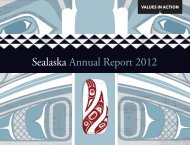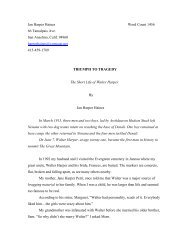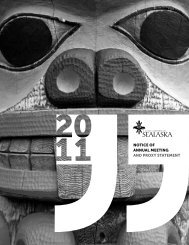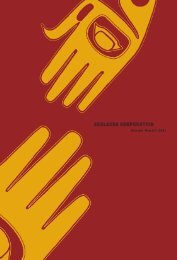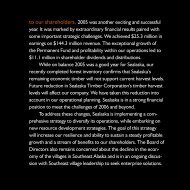Press Release: Sealaska Leadership Speaks Out for Land Legislation
Press Release: Sealaska Leadership Speaks Out for Land Legislation
Press Release: Sealaska Leadership Speaks Out for Land Legislation
Create successful ePaper yourself
Turn your PDF publications into a flip-book with our unique Google optimized e-Paper software.
For Immediate <strong>Release</strong> – April 23, 2013<br />
<strong>Sealaska</strong> <strong>Leadership</strong> <strong>Speaks</strong> <strong>Out</strong> <strong>for</strong> <strong>Land</strong> <strong>Legislation</strong><br />
JUNEAU, Alaska – The Southeast Alaska Native <strong>Land</strong> Entitlement Finalization and Jobs<br />
Protection Act, or S. 340, introduced by Senator Lisa Murkowski (R-AK), is scheduled <strong>for</strong> a<br />
hearing on April 25 by the Public <strong>Land</strong>s Subcommittee of the U.S. Senate Committee on<br />
Energy and Natural Resources. This Senate bill has been subject of a half dozen<br />
congressional hearings, and hundreds of amendments to address the concerns raised at<br />
myriad stakeholder meetings. S. 340 has garnered the support from a diverse array of<br />
conservation, business, tribal and local community interests. <strong>Sealaska</strong> leadership provides<br />
their insight on how this legislation is the best solution <strong>for</strong> stakeholders:<br />
“This legislation is unique by blending conservation and protection of publicly important places,<br />
while providing resources <strong>for</strong> sustainable jobs in economically deprived rural communities,”<br />
said Bill Thomas, <strong>Sealaska</strong> director, commercial fisherman and <strong>for</strong>mer Alaska State<br />
Representative. “It finds a sustainable balance among a variety of competing interests.”<br />
Bruce Botelho, <strong>for</strong>mer mayor of the City and Borough of Juneau, Alaska stated, “Senator<br />
Murkowski, the conservation and business stakeholders of Southeast Alaska and <strong>Sealaska</strong><br />
deserve a great deal of credit <strong>for</strong> working together to find the solution embodied in S. 340.”<br />
Under S. 340, <strong>Sealaska</strong> receives only the acres Congress authorized under the 42-year-old<br />
Alaska Native Claims Settlement Act according to Albert Kookesh, chair of the <strong>Sealaska</strong><br />
board. “This legislation allows <strong>Sealaska</strong> to be a positive economic contributor to our rural<br />
communities, and with <strong>Sealaska</strong>’s support guarantees the land received will remain open <strong>for</strong><br />
public access <strong>for</strong> the benefit of sportsmen, recreationalists and subsistence users. This<br />
legislation provides unprecedented right to use <strong>Sealaska</strong> lands and grants a right these users<br />
would not have if <strong>Sealaska</strong> selected from the current withdrawals.”<br />
This bill ensures that many national treasures that are currently available <strong>for</strong> <strong>Sealaska</strong><br />
selection instead remain in public ownership. They will be removed from <strong>Sealaska</strong> selection<br />
rights with the legislation according to <strong>Sealaska</strong> Board Vice Chair Dr. Rosita Worl. “Under this<br />
legislation <strong>Sealaska</strong> will <strong>for</strong>ego its selection rights to many publically important areas. The<br />
conservation benefits of this legislation goes beyond just a few truly unique areas by including<br />
150,000 acres of newly designated conservation lands. Much of these lands were conservation<br />
priorities by regional conservation organizations and fishermen since the 1990 Tongass<br />
Timber Re<strong>for</strong>m Act, which failed to include these recreationally and ecologically important<br />
areas in that legislation.”<br />
This legislation allows <strong>Sealaska</strong> to select the lands from areas that provide economic<br />
opportunities and without unnecessarily disrupting the Wildlife Conservation Strategy under the<br />
Tongass <strong>Land</strong> Management Plan according to Rick Harris, executive vice president of<br />
<strong>Sealaska</strong>. “The selections represent less than one percent impact to large tree-old growth<br />
areas,” he said. “After <strong>Sealaska</strong>’s selection, 76 percent of the original Tongass National Forest<br />
large tree <strong>for</strong>est lands remain intact and in a status of permanent preservation.”
<strong>Sealaska</strong> partners with scientists and professors from Oregon State University, the University<br />
of Washington and government researchers to guide <strong>Sealaska</strong>’s land use practices to protect<br />
fish and wildlife habitat and create healthy <strong>for</strong>ests according to Ron Wolfe, <strong>Sealaska</strong> natural<br />
resources manager. “<strong>Sealaska</strong> <strong>for</strong>est land and resource stewardship is the gold standard in<br />
Alaska.”<br />
“Many hunters and recreationalists seek harvested areas and managed <strong>for</strong>est stands such as<br />
those on <strong>Sealaska</strong> lands <strong>for</strong> the abundance of wildlife <strong>for</strong> viewing and hunting,” Wolfe added.<br />
“Some will claim that 30 years after timber harvest the land’s ability to support wildlife declines<br />
and remains very low <strong>for</strong> a century. The idea that young and advanced <strong>for</strong>ests do not support<br />
wildlife is outdated and based on what happens on unmanaged and neglected <strong>for</strong>est lands—<br />
this does not apply to <strong>Sealaska</strong> managed lands.”<br />
The Western Governors’ Association, in a letter to Secretary of Agriculture Thomas Vilsack,<br />
stated “We have been concerned <strong>for</strong> some time that federal <strong>for</strong>est lands throughout the West<br />
are experiencing serious environmental stresses that affect the health and vitality of these<br />
ecosystems. They are overgrown; they exhibit all the symptoms of an unhealthy ecosystem;<br />
and they demand urgent attention. Now is the time <strong>for</strong> the U.S. Forest Service to accelerate its<br />
ef<strong>for</strong>ts to promote sound <strong>for</strong>est management policies that maintain ecological balance.” None<br />
of these conditions exist on <strong>Sealaska</strong> lands, according to <strong>Sealaska</strong> President and CEO Chris<br />
E. McNeil Jr. “<strong>Sealaska</strong> has a proven track record of <strong>for</strong>est stewardship, and all of our <strong>for</strong>est<br />
and stand management practices are current with over $25 million invested in <strong>for</strong>est<br />
management. We are driven to provide <strong>for</strong> the health of our <strong>for</strong>ests based on our Native values<br />
and the best science and we are proud of this per<strong>for</strong>mance.”<br />
<strong>Sealaska</strong>, Values In Action<br />
<strong>Sealaska</strong> has strengthened business with culture since 1972. We are a Native institution<br />
owned by more than 21,000 tribal member shareholders whose core cultural values guide all<br />
that <strong>Sealaska</strong> does and represent the rich heritage of our Tlingit, Haida and Tsimshian people.<br />
We live our values to build excellence in our Native enterprise and take action towards our<br />
purpose: to strengthen our people, culture and homelands.<br />
Contact:<br />
Nicole Hallingstad<br />
Cell 907.209.1089<br />
Nicole.hallingstad@sealaska.com<br />
Find <strong>Sealaska</strong> online: www.sealaska.com


